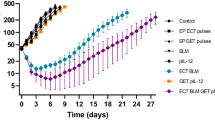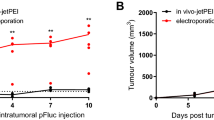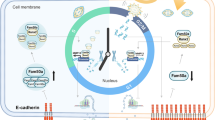Abstract
This investigation aims to determine experimentally whether or not ultrasound (US) irradiation is effective in enhancing the in vivo gene expression of NK4 plasmid DNA and suppressing tumor growth. NK4, composed of the NH2-terminal hairpin and subsequent four-kringle domains of hepatocyte growth factor (HGF), acts as an HGF-antagonist and angiogenesis inhibitor. Dextran was cationized by introducing spermine to the hydroxyl groups to allow for polyionic complexation with NK4 plasmid DNA. The cationized dextran was additionally modified with poly(ethylene glycol) (PEG) molecules giving PEG engrafted cationized dextran. Significant suppression of tumor growth was observed when PEG engrafted cationized dextran–NK4 plasmid DNA complexes were intravenously injected into mice carrying a subcutaneous Lewis lung carcinoma tumor mass with subsequent US irradiation when compared with the cationized dextran–NK4 plasmid DNA complex and naked NK4 plasmid DNA with or without US irradiation. We conclude that complexation with PEG-engrafted cationized dextran in combination with US irradiation is a promising way to target the NK4 plasmid DNA to the tumor for gene expression.
This is a preview of subscription content, access via your institution
Access options
Subscribe to this journal
Receive 12 print issues and online access
$259.00 per year
only $21.58 per issue
Buy this article
- Purchase on Springer Link
- Instant access to full article PDF
Prices may be subject to local taxes which are calculated during checkout









Similar content being viewed by others
References
Nakamura T, Nishizawa T, Hagiya M, Seki T, Shimonishi M, Sugimura A et al. Molecular cloning and expression of human hepatocyte growth factor. Nature 1989; 342: 440–443.
Zarnegar R, Michalopoulos GK . The many faces of hepatocyte growth factor: from hepatopoiesis to hematopoiesis. J Cell Biol 1995; 129: 1177–1180.
Matsumoto K, Nakamura T . Hepatocyte growth factor (HGF) as a tissue organizer for organogenesis and regeneration. Biochem Biophys Res Commun 1997; 239: 639–644.
Birchmeier C, Gherardi E . Developmental roles of HGF/SF and its receptor, the c-Met tyrosine kinase. Trends Cell Biol 1998; 8: 404–410.
Van Belle E, Witzenbichler B, Chen D, Silver M, Chang L, Schwall R et al. Potentiated angiogenic effect of scatter factor/hepatocyte growth factor via induction of vascular endothelial growth factor: the case for paracrine amplification of angiogenesis. Circulation 1998; 97: 399–409.
Taniyama Y, Morishita R, Aoki M, Nakagami H, Yamamoto K, Yamazaki K et al. Therapeutic angiogenesis induced by human hepatocyte growth factor gene in rat and rabbit hindlimb ischemia models: preclinical study for treatment of peripheral arterial disease. Gene Therapy 2001; 8: 181–189.
Matsuda Y, Matsumoto K, Ichida T, Nakamura T . Hepatocyte growth factor suppresses the onset of liver cirrhosis and abrogates lethal hepatic dysfunction in rats. J Biochem 1995; 118: 634–639.
Mizuno S, Kurosawa T, Matsumoto K, Mizuno-Horikawa Y, Okamoto M, Nakamura T . Hepatocyte growth factor prevents renal fibrosis and dysfunction in a mouse model of chronic renal disease. J Clin Invest 1998; 101: 1827–1834.
Yaekashiwa M, Nakayama S, Ohnuma K, Sakai T, Abe T, Satoh K et al. Simultaneous or delayed administration of hepatocyte growth factor equally represses the fibrotic changes in murine lung injury induced by bleomycin. Am J Respir Crit Care Med 1997; 156: 1937–1944.
Ishiki Y, Ohnishi H, Muto Y, Matsumoto K, Nakamura T . Direct evidence that hepatocyte growth factor is a hepatotrophic factor for liver regeneration and has a potent antihepatitis effect in vivo. Hepatology 1992; 16: 1227–1235.
Ohmichi H, Matsumoto K, Nakamura T . In vivo mitogenic action of HGF on lung epithelial cells: pulmotrophic role in lung regeneration. Am J Physiol 1996; 270: L1031–L1039.
Cortner J, Vande Woude GF, Rong S . The Met-HGF/SF autocrine signaling mechanism is involved in sarcomagenesis. EXS 1995; 74: 89–121.
Rosen EM, Goldberg ID . Scatter factor and angiogenesis. Adv Cancer Res 1995; 67: 257–279.
Jeffers M, Rong S, Vande Woude GF . Hepatocyte growth factor/scatter factor-Met signaling in tumorigenicity and invasion/metastasis. J Mol Med 1996; 74: 505–513.
To CT, Tsao MS . The roles of hepatocyte growth factor/scatter factor and met receptor in human cancers. Oncol Rep 1998; 5: 1013–1024.
Jiang WG, Hiscox S, Matsumoto K, Nakamura T . Hepatocyte growth factor/scatter factor, its molecular, cellular and clinical implications in cancer. Crit Rev Oncol Hematol 1999; 29: 209–248.
Date K, Matsumoto K, Shimura H, Tanaka M, Nakamura T . HGF/NK4 is a specific antagonist for pleiotrophic actions of hepatocyte growth factor. FEBS Lett 1997; 420: 1–6.
Date K, Matsumoto K, Kuba K, Shimura H, Tanaka M, Nakamura T . Inhibition of tumor growth and invasion by a four-kringle antagonist (HGF/NK4) for hepatocyte growth factor. Oncogene 1998; 17: 3045–3054.
Kuba K, Matsumoto K, Date K, Shimura H, Tanaka M, Nakamura T . HGF/NK4, a four-kringle antagonist of hepatocyte growth factor, is an angiogenesis inhibitor that suppresses tumor growth and metastasis in mice. Cancer Res 2000; 60: 6737–6743.
Tomioka D, Maehara N, Kuba K, Mizumoto K, Tanaka M, Matsumoto K et al. Inhibition of growth, invasion, and metastasis of human pancreatic carcinoma cells by NK4 in an orthotopic mouse model. Cancer Res 2001; 61: 7518–7524.
Saga Y, Mizukami H, Suzuki M, Urabe M, Kume A, Nakamura T et al. Expression of HGF/NK4 in ovarian cancer cells suppresses intraperitoneal dissemination and extends host survival. Gene Therapy 2001; 8: 1450–1455.
Maehara N, Nagai E, Mizumoto K, Sato N, Matsumoto K, Nakamura T et al. Gene transduction of NK4, HGF antagonist, inhibits in vitro invasion and in vivo growth of human pancreatic cancer. Clin Exp Metastasis 2002; 19: 417–426.
Hirao S, Yamada Y, Koyama F, Fujimoto H, Takahama Y, Ueno M et al. Tumor suppression effect using NK4, a molecule acting as an antagonist of HGF, on human gastric carcinomas. Cancer Gene Therapy 2002; 9: 700–707.
Saimura M, Nagai E, Mizumoto K, Maehara N, Okino H, Katano M et al. Intraperitoneal injection of adenovirus-mediated NK4 gene suppresses peritoneal dissemination of pancreatic cancer cell line AsPC-1 in nude mice. Cancer Gene Therapy 2002; 9: 799–806.
Maemondo M, Narumi K, Saijo Y, Usui K, Tahara M, Tazawa R et al. Targeting angiogenesis and HGF function using an adenoviral vector expressing the HGF antagonist NK4 for cancer therapy. Mol Therapy 2002; 5: 177–185.
Taniyama Y, Tachibana K, Hiraoka K, Namba T, Yamasaki K, Hashiya N et al. Local delivery of plasmid DNA into rat carotid artery using ultrasound. Circulation 2002; 105: 1233–1239.
Kim HJ, Greenleaf JF, Kinnick RR, Bronk JT, Bolander ME . Ultrasound-mediated transfection of mammalian cells. Hum Gene Therapy 1996; 7: 1339–1346.
Frediani B, Falsetti P, Storri L, Allegri A, Bisogno S, Baldi F et al. Ultrasound and clinical evaluation of quadricipital tendon enthesitis in patients with psoriatic arthritis and rheumatoid arthritis. Clin Rheumatol 2002; 21: 294–298.
Binderman I, Shimshoni Z, Somjen D . Biochemical pathways involved in the translation of physical stimulus into biological message. Calcif Tissue Int 1984; 36: 82–85.
Duarte LR . The stimulation of bone growth by ultrasound. Arch Ortho Trauma Surg 1983; 101: 153–159.
Mitragotri D, Blankschtein D, Langer R . Ultrasound-mediated transdermal protein delivery. Science 1995; 269: 850–853.
Tezel A, Sens A, Tuchscherer J, Mitragotri S . Synergistic effect of low-frequency ultrasound and surfactants on skin permeability. J Pharm Sci 2002; 91: 91–100.
Mitragotri S, Kost J . Transdermal delivery of heparin and low-molecular weight heparin using low-frequency ultrasound. Pharm Res 2001; 18: 1151–1156.
Mitragotri S . Effect of therapeutic ultrasound on partition and diffusion coefficients in human stratum corneum. J Control Rel 2001; 71: 23–29.
Fechheimer M, Boylan JF, Parker S . Transfection of mammalian cells with plasmid DNA by scrape loading and sonication loading. Proc Natl Acad Sci USA 1987; 84: 8463–8467.
Wyber JA, Andrews J, D'Emanuele A . The use of sonication for the efficient delivery of plasmid DNA into cells. Pharm Res 1997; 14: 750–756.
Taniyama Y, Tachibana K, Hiraoka K, Aoki M, Yamamoto S, Matsumoto K et al. Development of safe and efficient novel nonviral gene transfer using ultrasound: enhancement of transfection efficiency of naked plasmid DNA in skeletal muscle. Gene Ther 2002; 9: 372–380.
Anwer K, Kao G, Proctor B, Anscombe I, Florack V, Earls R et al. Ultrasound enhancement of cationic lipid-mediated gene transfer to primary tumors following systemic administration. Gene Ther 2000; 7: 1833–1839.
Nishikawa M . Demonstration of the receptor-mediated hepatic uptake of dextran in mice. J Pharm Pharmacol 1992; 44: 396–401.
Takakura Y, Takagi A, Hashida M, Sezaki H . Disposition and tumor localization of mitomycin C-dextran conjugates in mice. Pharm Res 1987; 4: 223–230.
Noguchi A . Preparation and properties of the immunoconjugate composed of anti-human colon cancer monoclonal antibody and mitomycin C-dextran conjugate. Bioconjug Chem 1992; 3: 132–137.
Hosseinkhani H, Azzam T, Tabata Y, Domb AJ . Dextran-spermine polycation: an efficient non-viral vector for in vitro and in vivo gene transfection. Gene Ther 2004; 11: 194–203.
Hermanson GT, Mallia AK, Smith PK . Immobilized Affinity Ligand Techniques. San Diego, CA: Academic Press, 1992, pp. 51–136.
Snyder SL, Sobocinski PZ . An improved 2,4,6-trinitrobenzenesulfonic acid method for the determination of amines. Anal Biochem 1975; 64: 284–288.
Hosseinkhani H, Tabata Y . Ultrasound enhances in vivo tumor expression of plasmid DNA by PEG-introduced cationized dextran. J Control Rel (epub ahead of print 7th October 2005).
Kircheis R, Wightman L, Schreiber A, Robitza B, Rossler V, Kursa M et al. Polyethylenimine/DNA complexes shielded by transferrin target gene expression to tumors after systemic application. Gene Ther 2001; 8: 28–40.
Sato N, Kobayashi H, Saga T, Nakamoto Y, Ishimori T, Togashi K et al. Tumor targeting and imaging of intraperitoneal tumors by use of antisense oligo-DNA complexed with dendrimers and/or avidin in mice. Clin Cancer Res 2001; 7: 3606–3612.
Unger EC, Mccreery TP, Sweitzer RH . Ultrasound enhances gene expression of liposomal transfection. Invest Radiol 1997; 32: 723–727.
Crum LA, Roy RA, Dinno MA . Acoustic cavitation produced by microsecond pulses of ultrasound: a discussion of some selected results. J Acoust Soc Am 1992; 91: 1113–1119.
Hanahan D, Folkman J . Patterns and emerging mechanisms of the angiogenic switch during tumorigenesis. Cell 1996; 86: 353–364.
Sim BK, MacDonald NJ, Gubish ER . Angiostatin and endostatin: endogenous inhibitors of tumor growth. Cancer Metastasis Rev 2000; 19: 181–190.
Kuba K, Matsumoto K, Ohnishi K, Shiratsuchi T, Tanaka M, Nakamura T . Kringle 1-4 of hepatocyte growth factor inhibits proliferation and migration of human microvascular endothelial cells. Biochem Biophys Res Commun 2000; 279: 846–852.
Kushibiki T, Matsumoto K, Nakamura T, Tabata Y . Suppression of tumor metastasis by NK4 plasmid DNA released from cationized gelatin. Gene Therapy 2004; 11: 1205–1214.
Holmgren L, O'Reilly MS, Folkman J . Dormancy of micrometastases: balanced proliferation and apoptosis in the presence of angiogenesis suppression. Nat Med 1995; 1: 149–153.
O'Reilly MS, Holmgren L, Chen C, Folkman J . Angiostatin induces and sustains dormancy of human primary tumors in mice. Nat Med 1996; 2: 689–692.
Acknowledgements
The Japan Society for the Promotion of Science (JSPS) is greatly acknowledged for the support of this work.
Author information
Authors and Affiliations
Corresponding author
Additional information
The authors have retracted this article because Figs. 4, 6 and 7 contain duplicated and modified figures from prior publications which have now been retracted.
All authors agree to this retraction.
An erratum to this article can be found online at http://dx.doi.org/10.1038/s41417-019-0148-0.
About this article
Cite this article
Hosseinkhani, H., Kushibiki, T., Matsumoto, K. et al. RETRACTED ARTICLE: Enhanced suppression of tumor growth using a combination of NK4 plasmid DNA-PEG engrafted cationized dextran complex and ultrasound irradiation. Cancer Gene Ther 13, 479–489 (2006). https://doi.org/10.1038/sj.cgt.7700918
Received:
Revised:
Accepted:
Published:
Issue Date:
DOI: https://doi.org/10.1038/sj.cgt.7700918
Keywords
This article is cited by
-
Biodegradable nanoparticles for gene therapy technology
Journal of Nanoparticle Research (2013)
-
New generation of β-cyclodextrin-chitosan nanoparticles encapsulated quantum dots loaded with anticancer drug for tumor-target drug delivery and imaging of cancer cells
Journal of Nanoparticle Research (2013)
-
Engineering of magnetic DNA nanoparticles for tumor-targeted therapy
Journal of Nanoparticle Research (2013)
-
Targeted gene delivery in tumor xenografts by the combination of ultrasound-targeted microbubble destruction and polyethylenimine to inhibit survivin gene expression and induce apoptosis
Journal of Experimental & Clinical Cancer Research (2010)
-
Role of frequency and mechanical index in ultrasonic-enhanced chemotherapy in rats
Cancer Chemotherapy and Pharmacology (2009)



